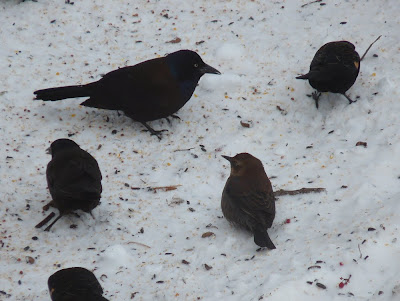I knew some fascinating sightings would be had at bird feeders today, and there will likely be even more tomorrow. I had two interesting birds, the first being very likely the same Fox Sparrow that visited me last Thursday (photos of it tomorrow). The second was another species I recorded that day, a Rusty Blackbird!


They are a classic feeder species after a snowfall of more than about three inches. I believe this is because that depth hinders what they can do in terms of their style of foraging. Apart from picking at what is on the earth they shove their bill into the mud, water, leaves, snow or whatever else, opening it and exposing food. When the snowfall gets above a few inches accessing that food probably proves much more difficult to accomplish for their species in particular.
She arrived late this morning and was loosely associated with a group of Red-winged Blackbirds. She would stay on the ground if all the birds were flushed, and return faster if she was scared off momentarily, too. Apart from snow removal and other human activity a Sharp-shinned Hawk and Cooper's Hawk kept the birds on heightened alert. Rusty Blackbirds are usually bolder than other blackbirds in this way.
She fed primarily on cracked corn, a typical food for the species at feeders. I find that some birds, often males more than females, eat bits of suet that fall while woodpeckers or other birds peck at cakes. This bird did not, keeping to the corn and digging into the snow when she had to for some of it.
Another interesting Rusty Blackbird behavior is their tendency to flick their tails open and closed while they walk around and feed. You can see the tail open and in motion in this photo.

I am sure many people saw Rusty Blackbirds in their yard today, especially in Fairfield and Litchfield counties, the areas hardest hit by the storm. It is of vital importance to log these sightings into eBird including all of the details you can. They are one of the fastest declining species in North America. Your observations of their wintering population, from sex of the birds to habitat selection and foraging behavior can help scientists discover why their numbers are plummeting.
Photos © Scott Kruitbosch





No comments:
Post a Comment